This supplementary material highlights SGI President Ikeda’s activities and significant events in the Soka Gakkai’s history from 1960 through 1966 that are covered in volumes 1 through 10 of The New Human Revolution. This material appeared in the August 7 and 21, 2019, issues of the Seikyo Shimbun, the Soka Gakkai’s daily newspaper.
1960: The Year of Advancement
May 3: Daisaku Ikeda inaugurated as third Soka Gakkai President. (The New Human Revolution, vol. 1, revised edition, p. 142)
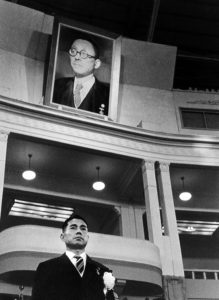
On May 3, 1960, Daisaku Ikeda is inaugurated as the third Soka Gakkai president, Nihon University Auditorium, Ryogoku, Tokyo. Photo by Seikyo Press.
Inauguration as the Third Soka Gakkai President
On May 3, 1960, Daisaku Ikeda was inaugurated as the third Soka Gakkai president in a ceremony that was held at the Nihon University Auditorium in Ryogoku, Tokyo. Standing under a large photograph of his mentor, second Soka Gakkai President Josei Toda, he determined to usher in the dawn of worldwide kosen-rufu in the spirit of the oneness of mentor and disciple.
On this day, the Soka Gakkai set a goal of accomplishing a membership of 3 million households by April 2, 1964, the sixth anniversary of Mr. Toda’s passing.
May 8: Attends Kansai General Chapter Leaders Meeting. (NHR-2, revised edition, 9)
May 9: Attends Young Women’s Division Leaders Meeting. (NHR-2, revised edition, 18)
May 10: Attends Young Men’s Division Leaders Meeting. (NHR-2, revised edition, 24)
May 22: Attends Hokkaido General Chapter Leaders Meeting. (NHR-2, revised edition, 30)
May 29: Attends Kyushu General Chapter Leaders Meeting. (NHR-2, revised edition, 30)
June 4: Attends Tohoku General Chapter Leaders Meeting. (NHR-2, revised edition, 30)
June 10: Attends Chubu General Chapter Leaders Meeting. (NHR-2, revised edition, 30)
June 12: Attends Chugoku General Chapter Leaders Meeting. (NHR-2, revised edition, 30)
July 16: Makes first guidance trip to Okinawa. Attends the inaugural meeting for Okinawa Chapter the following day. (NHR-2, revised edition, 42)
July 22: Attends the Second Women’s Division Convention. (NHR-2, revised edition, 79)
August 27: Visits Josei Toda’s hometown of Atsuta, Hokkaido. (NHR-2, revised edition, 145)
September 23: Attends the Third Festival of Youth, a national Soka Gakkai sports meet. (NHR-2, revised edition, 152)
October 2: Departs for his first trip to North and South America. (NHR-1, revised edition, 1) Attends a discussion meeting in Honolulu. Establishes the first district outside of Japan. (NHR-1, revised edition, 35)
October 3: Visits San Francisco. Attends a discussion meeting the following day, where he offers three points of guidance to the gathering of mostly Japanese immigrants: 1) become American citizens; 2) get a driver’s license; and 3) master English. (NHR-1, revised edition, 65)
October 6: Arrives in Seattle and tours the city. (NHR-1, revised edition, 127)
October 8: Visits Chicago. Attends a discussion meeting the following day. (NHR-1, revised edition, 150)
October 11: Visits Toronto. Tours Niagara Falls the following day. (NHR-1, revised edition, 175)
October 13: Arrives in New York. (NHR-1, revised edition, 197)
October 14: Visits the United Nations Headquarters. (NHR-1, revised edition, 199)
October 16: Visits Washington, D.C., and attends a discussion meeting. (NHR-1, revised edition, 212)
October 19: Arrives in São Paulo, Brazil. Establishes the first chapter outside of Japan at a discussion meeting the following day. (NHR-1, revised edition, 252)
October 22: Visits Los Angeles and establishes the first chapter in the United States at a discussion meeting. Returns to Japan on October 25. (NHR-1, revised edition, 285)
November 1: Establishes Chiba Chapter. During this month, he attends meetings throughout Japan to establish new chapters. (NHR-2, revised edition, 162)
November 6: Attends the Ninth Young Men’s Division General Meeting. (NHR-2, revised edition, 175)
November 18: Attends a memorial for the 16th anniversary of founding Soka Gakkai President Tsunesaburo Makiguchi’s passing. (NHR-2, revised edition, 240)
November 20: Attends the Eighth Young Women’s Division General Meeting. (NHR-2, revised edition, 247)
December 4: Attends a meeting establishing Oita Chapter. During this month, he attends meetings throughout Japan to establish new chapters. (NHR-2, revised edition, 281)
December 7: Attends the completion and Gohonzon enshrining ceremony of the new Chugoku Headquarters building in Okayama City. (NHR-2, revised edition, 294)
1961: The Year of Dynamic Advancement
January 1: Attends a New Year’s Gongyo Meeting, ushering in the Year of Dynamic Advancement. (NHR-3, revised edition, 2)
January 8: Attends a meeting to establish three general chapters in Kyushu. During this month, he attends meetings throughout Japan to establish new chapters. (NHR-3, revised edition, 16)
January 28: Makes first trip to other Asian countries. Holds a discussion meeting in Hong Kong and establishes the first district in Asia outside of Japan. (NHR-3, revised edition, 40)
January 29: Arrives in Colombo, Ceylon <present-day Sri Lanka>. (NHR-3, revised edition, 67)
January 31: Arrives in Madras, India <present-day Chennai>. (NHR-3, revised edition, 86)
February 1: Tours Mahatma Gandhi’s monument in Raj Ghat, New Delhi. (NHR-3, revised edition, 92)
February 2: Tours the Taj Mahal in Agra. (NHR-3, revised edition, 122)
February 3: Arrives in Patna, India, and visits the Ganges River. (NHR-3, revised edition, 125)
February 4: Holds a ceremony to bury a plaque that reads “Kosen-rufu in Asia” in Bodhgaya, the site of Shakyamuni’s enlightenment. (NHR-3, revised edition, 129)
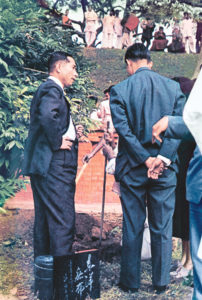
President Ikeda buries a stone plaque that reads “Kosen-rufu in Asia” in Bodhgaya, India,
February 4, 1961. Photo by Seikyo Press.
The Dawn of Kosen-rufu in Asia
On February 4, 1961, President Ikeda visited Bodhgaya, the site of Shakyamuni’s enlightenment, and buried a stone plaque that reads “Kosen-rufu in Asia” and other items. He took the initial step for realizing Nichiren Daishonin’s prophecy of the westward transmission of Buddhism and the actualization of President Toda’s will embodied in his poem that reads in part, “To the people of Asia, let us send them the light of the sun” (NHR-3, revised edition, 138).
February 5: Visits Calcutta, India <present-day Kolkata>. (NHR-3, revised edition, 228)
February 7: Arrives in Rangoon, Burma <present-day Yangon, Myanmar>. The following day, he visits a cemetery and attends a memorial for his brother, Kiichi, and all the soldiers who died fighting in Burma. (NHR-3, revised edition, 242)
February 9: Visits Bangkok, Thailand, and formulates a vision to establish an institute that researches the philosophy, culture and anthropology of Asia. Later establishes the Oriental Institute of Philosophy. Also envisions the development of a cultural association where various countries would have exchanges of music and the arts. Later establishes the Min-On Concert Association. (NHR-3, revised edition, 277)
February 11: Visits Siem Reap, Cambodia, and tours famous temples such as Angkor Wat. (NHR-3, revised edition, 288)
February 13: Arrives in Hong Kong and discusses how to develop organizations in various Asian countries. Returns to Japan on February 14. (NHR-3, revised edition, 296)
February 16: Attends a meeting establishing Hojo Chapter in Aichi Prefecture. During this month, he attends meetings throughout Japan to establish new chapters. (NHR-4, revised edition, 2)
March 16: Attends the youth division’s first music festival. (NHR-4, revised edition, 34)
April 2: Attends a memorial for the third anniversary of President Toda’s passing. (NHR-4, revised edition, 61)
April 3: Attends a meeting establishing Takasaki Chapter in Gunma Prefecture. During this month, he attends meetings throughout Japan to establish new chapters. (NHR-4, revised edition, 66)
May 3: Attends the Headquarters General Meeting commemorating his first anniversary as Soka Gakkai president. (NHR-4, revised edition, 120)
May 9: Attends a meeting establishing Maizuru Chapter in Kyoto. During this month, he attends meetings throughout Japan to establish new chapters. (NHR-4, revised edition, 147)
June 27: Attends the June Headquarters Leaders Meeting, at which it is announced that the Soka Gakkai has surpassed 2 million households. (NHR-4, revised edition, 201)
October 4: Departs on his first trip to Europe. (NHR-4, revised edition, 264)
October 5: Arrives in Copenhagen, Denmark, and tours the city. (NHR-4, revised edition, 265)
October 7: Arrives in Dusseldorf, West Germany <present-day Germany>, and tours the city. (NHR-4, revised edition, 284)
October 8: Visits the Brandenburg Gate. (NHR-4, revised edition, 312)
October 9: Visits Cologne, West Germany <present-day Germany>, and visits a leading German diesel engine factory. (NHR-5, revised edition, 7)
October 10: Arrives in Amsterdam, Netherlands. (NHR-5, revised edition, 15)
October 11: Arrives in Paris, France. Tours the city the following day. (NHR-5, revised edition, 20)
October 13: Arrives in London. Tours the city the following day. (NHR-5, revised edition, 40)
October 15: Arrives in Madrid, Spain. (NHR-5, revised edition, 67)
October 16: Arrives in Zurich, Switzerland, and tours the city. (NHR-5, revised edition, 76)
October 18: Arrives in Vienna, Austria, and tours the city. (NHR-5, revised edition, 93)
October 19: Arrives in Rome, Italy, and tours the city. (NHR-5, revised edition, 108)
October 20: Visits the Vatican. Returns to Japan on October 23. (NHR-5, revised edition, 110)
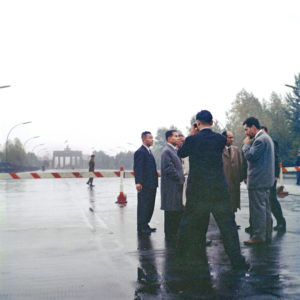
President Ikeda visits the Brandenburg Gate, October 8, 1961. By Seikyo Press.
First Steps in Europe
In October 1961, President Ikeda embarked on his first trip for European kosen-rufu, traveling to nine countries in 20 days. In then-West Germany, he stood before the Brandenburg Gate, the symbol of the Cold War’s division between Eastern and Western bloc nations, stating with conviction that within 30 years this barrier would no longer exist.
November 5: Attends the 10th Young Men’s Division General Meeting. (NHR-5, revised edition, 160)
November 12: Attends the Ninth Young Women’s Division General Meeting. (NHR-5, revised edition, 186)
November 20: Attends the completion and Gohonzon enshrining ceremony for the Tohoku Headquarters building. Tohoku’s song, “Song of the New Century,” is introduced. (NHR-5, revised edition, 212)
1962: The Year of Victory
January 1: Attends a New Year’s Gongyo meeting ushering in The Year of Victory. (NHR-5, revised edition, 235)
January 25: Exonerated by the court of all charges in the Osaka Incident. (NHR-5, revised edition, 296)
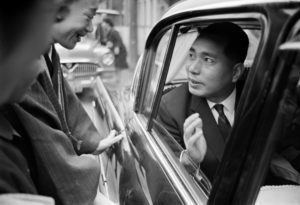
President Ikeda encourages a women’s division member before leaving for Osaka District Court on January 25, 1962. By Seikyo Press.
Osaka Incident Trial: President Ikeda Exonerated
On July 3, 1957, President Ikeda (then youth division chief of staff) was falsely accused and arrested for election law violations in the House of Councillors by-election. He was released on July 17 after undergoing intense interrogations during his 15-day confinement. After a four-and-a-half-year trial, the Osaka District Court delivered a “not guilty” verdict on January 25, 1962. Prosecutors did not appeal the acquittal, and President Ikeda’s innocence in the case was settled on February 8.
January 29: Departs for the Middle East. (NHR-6, revised edition, 1)
January 30: Arrives in Tehran, Iran, and tours the city. (NHR-6, revised edition, 17)
January 31: Arrives in Baghdad, Iraq, and tours the city. (NHR-6, revised edition, 44)
February 2: Arrives in Istanbul, Turkey, and tours a museum and other sites. (NHR-6, revised edition, 57)
February 4: Arrives in Athens, Greece, and tours the city. (NHR-6, revised edition, 69)
February 6: Arrives in Cairo, Egypt. Tours the city the following day. (NHR-6, revised edition, 89)
February 10: Arrives in Karachi, Pakistan, and tours the city. (NHR-6, revised edition, 102)
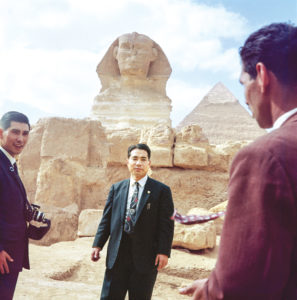
Visiting the Sphinx and the Pyramids at Giza in Egypt on February 7, 1962. By Seikyo Press.
First Visit to the Middle East
On January 29, 1962, President Ikeda departed for his first visit to the Middle East. He visited seven countries over 15 days, including Iran, Iraq, Turkey and Egypt. While in Egypt, he received word on February 8 that prosecutors in the Osaka Incident Trial, who sought his conviction, decided not to appeal the not-guilty verdict. His innocence was proven.
February 11: Visits Bangkok, Thailand, and establishes Bangkok Chapter, the first chapter in Asia outside of Japan. (NHR-6, revised edition, 116)
February 12: Arrives in Hong Kong and establishes Hong Kong Chapter. Returns to Japan. (NHR-6, revised edition, 119)
March 21: Attends the completion ceremony of the Shikoku Headquarters building in Takamatsu City, Kagawa Prefecture. (NHR-6, revised edition, 155)
April 2: Attends memorial for the fourth anniversary of Mr. Toda’s passing. (NHR-6, revised edition, 158)
May 3: Attends the 24th General Meeting, marking his second anniversary as Soka Gakkai president. (NHR-6, revised edition, 174)
July 18: Attends the opening ceremony of the Okinawa Headquarters building. (NHR-6, revised edition, 265)
August 1: Attends the First Education Department National Convention. (NHR-7, revised edition, 2)
August 31: Begins lecture series on The Record of the Orally Transmitted Teachings for representatives of the Student Division. (NHR-6, revised edition, 280)
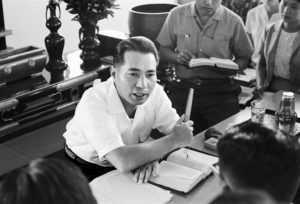
President Ikeda conducts a lecture on The Record of the Orally Transmitted Teachings to student division members, August 31, 1962. Photo by Seikyo Press.
Lectures on The Record of the Orally Transmitted Teachings
On August 31, 1962, President Ikeda began his lectures on The Record of the Orally Transmitted Teachings to representatives of the student division. He expressed his aspirations for these 40 youth, saying, “Develop yourselves to become exemplary leaders of the Soka Gakkai and of society as a whole” (NHR-6, revised edition, p. 279). He personally nurtured successors through these lectures, which continued for nearly five years.
October 6: Departs for the First Kansai Music Festival. Music and culture festivals occur in various places throughout Japan during this month. (NHR-7, revised edition, 34)
November 27: Attends the 31st Headquarters Leaders Meeting, at which it is announced that the Soka Gakkai has surpassed 3 million households. Establishes South America General Chapter. (NHR-7, revised edition, 76)
1963: The Year of Study
January 8: Departs for overseas trip. Establishes Hawaii Chapter. (NHR-7, revised edition, 93)
January 12: Attends the America West General Meeting. (NHR-7, revised edition, 132)
January 13: Attends the America East General Meeting, where New York Chapter is established. (NHR-7, revised edition, 143)
January 16: Establishes Europe General Chapter and Paris Chapter. (NHR-7, revised edition, 184)
January 26: Attends the Hong Kong Chapter Meeting. (NHR-7, revised edition, 240)
January 27: Encourages members at the airport in Taipei, Taiwan. Returns to Japan (NHR-7, revised edition, 249)
February 11: Writes a message titled “To the Women’s Division.” (NHR-7, revised edition, 291)
March 16: Attends a youth division speech contest. (NHR-7, revised edition, 323)
April 2: Attends memorial for the fifth anniversary of President Toda’s passing. (NHR-7, revised edition, 325)
May 3: Attends the 25th Headquarters General Meeting, marking his third anniversary as Soka Gakkai president. (NHR-8, 5)
June 22: Attends the kick-off meeting for Amami Oshima Chapter. (NHR-8, 67)
July 11: Writes an essay titled “Youth, Become World Leaders.” (NHR-8, 104)
July 28: Attends the First All-Japan Soka Gakkai Writers Department General Meeting. (NHR-8, 173)
September 1: Attends a meeting commemorating a new Soka Gakkai Headquarters building. (NHR-8, 202)
October 18: Attends a concert celebrating the establishment of the Min-On Concert Association. (NHR-8, 216)
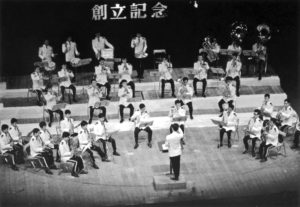
The establishment of the Min-On Concert Association is celebrated with a concert, October 18, 1963. Photo by Seikyo Press.
Min-On Concert Association Established
On October 18, 1963, a concert was held to celebrate the establishment of the Minshu Ongaku Kyokai (The People’s Concert Association), which is also referred to as the Min-On Concert Association. As part of its international exchange activities, the
Min-On Concert Association has engaged with artists from 110 countries and territories. It has organized approximately 80,000 performances by arts organizations, such as La Scala theater in Milan, Italy, and other groups, such as tango dancers from Argentina.
1964: The Year of Unity
April 1: On the eve of the memorial for the sixth anniversary of President Toda’s passing, he announces that he will write the continuation of his mentor’s novel, Human Revolution. (NHR-9, 13)
April 2: Attends a memorial for President Toda’s passing and declares the beginning of the “Essential Phase.” (NHR-9, 14)
May 3: Attends the 27th Headquarters General Meeting, marking his fourth anniversary as Soka Gakkai president. (NHR-9, 31)
May 12: Departs for Australia, Ceylon <present-day Sri Lanka> and India. (NHR-9, 45)
May 13: Arrives in Sydney, Australia, and tours the city. (NHR-9, 53)
May 15: Arrives in Melbourne, Australia, tours the city and establishes Melbourne Chapter. (NHR-9, 64)
May 19: Arrives in Ceylon <present-day Sri Lanka>, and tours universities and other significant sites. (NHR-9, 72)
May 22: Visits New Delhi, India, and tours the city. On May 24, returns to Japan. (NHR-9, 73)
June 7: Departs for the Tokyo No. 2 Headquarters High School Division Inaugural Meeting. On this day, each headquarters in Tokyo holds separate high school division inaugural meetings. (NHR-9, 92)
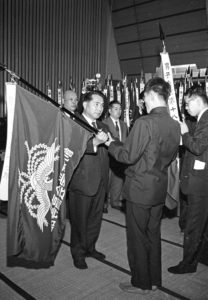
President Ikeda confers the high school division flag to a youth representative at the Soka Gakkai Headquarters in Shinanomachi, Tokyo, October 1965. By Seikyo Press.
The Junior High, High School and Elementary School Divisions Are Formed
On June 7, 1964, the high school division was established. This was the first division created by President Ikeda following his inauguration as third Soka Gakkai president. The junior high school division was formed on January 15, 1965, followed by the future division, which was established on September 23 of the same year.
June 30: Attends the Seventh Student Division General Meeting and announces his plan to establish Soka University. (NHR-9, 178)
October 2: Departs for Southeast Asia, the Middle East and Europe. Visits Bangkok via Hong Kong. (NHR-9, 179)
October 4: Visits Tehran, Iran, and tours the city. (NHR-9, 201)
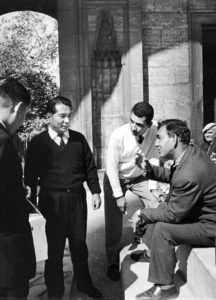
President Ikeda talks with locals
in Istanbul, Turkey, October 1964. By Seikyo Press.
October 5: Arrives in Istanbul, Turkey. (NHR-9, 204)
October 6: Visits Rome, Italy, and offers encouragement to district leaders. (NHR-9, 206)
October 8: Visits Paris, France. (NHR-9, 210)
October 10: Visits Prague, Czechoslovakia <present-day Czech Republic>. (NHR-9, 222)
October 11: Visits Budapest, Hungary. (NHR-9, 226)
October 12: Visits Zurich, Switzerland. (NHR-9, 234)
October 15: Attends a guidance meeting in Paris, France. (NHR-9, 237)
October 17: Tours Oslo, Norway, and visits Copenhagen, Denmark. On October 19, returns to Japan. (NHR-9, 253)
November 17: Sends a congratulatory telegram to the meeting establishing the Clean Government Party <Komeito>.(NHR-9, 328)
December 2: Begins writing The Human Revolution at the Okinawa Headquarters building. (NHR-10, 283)
December 27: Attends the completion ceremony of the Hokkaido Headquarters building. (NHR-9, 333)
1965: The Year of Victory
January 1: The serialization of his novel The Human Revolution begins in the New Year’s issue of the Seikyo Shimbun, the Soka Gakkai’s newspaper. (NHR-10, 1)
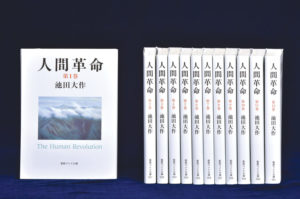
The Human Revolution, vols. 1–12 in Japanese. Photo by Seikyo Press.
President Ikeda Begins Writing The Human Revolution
President Ikeda began writing his novel series The Human Revolution in Okinawa, the stage of some of the fiercest land battles of World War II. Serialization of the novel began in the Seikyo Shimbun, the Soka Gakkai’s newspaper, on New Year’s Day 1965. Sensei wrote for the next 28 years to complete the 12 volumes of the series. The novel was serialized with a total of 1,509 installments.
January 16: Attends the completion ceremony of the Kyushu Headquarters building. (NHR-10, 10)
March 30: Attends the Nagano Headquarters district leaders meeting. Takes a commemorative photo with participants. (NHR-10, 26)
May 3: Attends the 28th General Meeting marking his fifth anniversary as Soka Gakkai president. (NHR-10, 28)
July 15: The Seikyo Shimbun begins circulation as a daily newspaper. (NHR-10, 39)
August 14: Departs for the United States and Mexico. (NHR-10, 86)
August 15: Visits the Los Angeles Center. Attends the first outdoor culture festival in the United States. (NHR-10, 88)
August 17: Arrives in Mexico City. Tours the city the following day. (NHR-10, 114)
August 19: Visits San Francisco. Returns to Japan on August 25.(NHR-10, 137)
October 3: Takes commemorative photos with Osaka group leaders and with Aichi group leaders the following day. (NHR-10, 145)
October 19: Departs for Europe. (NHR-10, 175)
October 20: Attends opening ceremony of the Soka Gakkai’s European office in Paris, France. (NHR-10, 176)
October 22: Visits Frankfurt, West Germany <present-day Germany>. Has a discussion with the members the following day. (NHR-10, 212)
October 24: Visits Milan, Italy, and tours the city. (NHR-10, 228)
October 27: Visits Lisbon, Portugal, and tours the city. (NHR-10, 234)
November 4: Takes commemorative photos with group leaders of Nara Headquarters. Holds commemorative photo sessions throughout the month in various locales across Japan. (NHR-10, 245)
1966: The Year of Dawn
January 8: Meets with Japan’s Prime Minister Eisaku Sato. (NHR-9, 143)
January 14: Attends the opening of the Hawaii Center. Returns to Japan on January 17. (NHR-10, 289)
March 5: Establishes the Men’s Division. (NHR-10, 317)
You are reading {{ meterCount }} of {{ meterMax }} free premium articles

